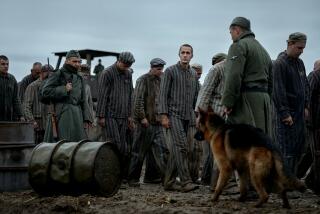A devoted daughter braves Nazis
- Share via
Though Hannah Senesh is often referred to as the Joan of Arc of Israel, the young writer and poet isn’t very well known outside that country.
In 1944, she was one of 32 Jews living in what was then Palestine who trained with the British army to parachute into Yugoslavia with the hopes of rescuing Jews in her native Hungary. Senesh, who had immigrated to Israel in 1939, was especially determined to find and liberate her mother, Catherine.
But the plans went awry. Senesh was captured, imprisoned and tortured by the Nazis but refused to give details of her mission.
During her incarceration, she was reunited with her mother, who was also imprisoned. In the end, Hannah Senesh was executed by a firing squad on Nov. 7, 1944, when she was 23.
Her story is retold in “Blessed Is the Match: The Life and Death of Hannah Senesh,” the first documentary about the World War II heroine. The film, which takes its title from her poem “Blessed Is the Match” and is narrated by Joan Allen, opens Friday in limited release.
The film’s director, Roberta Grossman, says she grew up obsessing about the Holocaust. “I didn’t lose any family that I know of, but for some reason it just gripped me,” she says. “I had friends whose parents were survivors who I knew. I had this profound awareness that these people were around us who had experienced something unfathomable.”
Grossman became aware of Senesh when she read her diary in junior high.
“That was one young person reading another young person’s diary,” she says. “I was taken with her high-minded idealism, her poetry, her sense of conviction and sort of a young person’s idea of black and white -- good and bad -- and nothing in between.”
After college, Grossman became a documentary filmmaker. For several years, she tried to get a project about Senesh off the ground, but couldn’t get the financing.
In retrospect, Grossman says, “I’m glad it didn’t happen, because when it came together 3 1/2 years ago, I had enough as a filmmaker to take on this iconic figure. I was a mother, and I was closer in age to Catherine than Hannah.”
Script writer and co-producer Sophie Sartain suggested that Grossman tell Hannah’s story through the eyes of Catherine, who survived her imprisonment and moved to Israel after the war and lived into her 90s.
“I don’t like to think of ‘Blessed Is the Match’ as a Holocaust film but as a mother-daughter love story set against the backdrop of the Holocaust,” Grossman says. (In addition to providing narration, Allen supplies Catherine’s voice-overs.)
Marta Kauffman, the co-creator and executive producer of “Friends,” is the film’s executive producer. Just as with Grossman, Kauffman became acquainted with Senesh’s legacy as a young girl.
“I went to camp and learned about her when I was kid. For we young women who were searching for female heroes, she was ideal,” Kauffman says. “When Roberta told me her take, that it was a mother- and-daughter story, as a mother I got very excited about it. It’s an amazing story.”
A family legacy
The Senesh family has long been protective of Hannah’s image and in the past had turned down requests for documentaries. Grossman says she spent a year on phone and e-mail negotiations with Hannah’s two nephews in Israel, and they turned her down.
“I put my head down on my desk for a couple of months,” Grossman says. “Then someone suggested that I go there.”
Within five minutes of meeting the nephews in Israel, they embraced Grossman and signed an agreement. The next day, one of Senesh’s nephews took her to what had been Catherine’s apartment. “In this little room [in the apartment], there are paintings, books and floor-to-ceiling shoe boxes with over 1,300 photographs, more than half taken by Hannah herself. It was coming as close to a documentarian’s orgasm as one could get.”
Grossman worked with scholars in Israel, Hungary and England to translate Catherine and Hannah’s correspondence and Hannah’s diary.
“We worked with scholars who helped us identify the year and the location of the photographs and to correlate them to the diary passages. The historical record is in better shape now because of the film.”
--
More to Read
Only good movies
Get the Indie Focus newsletter, Mark Olsen's weekly guide to the world of cinema.
You may occasionally receive promotional content from the Los Angeles Times.











